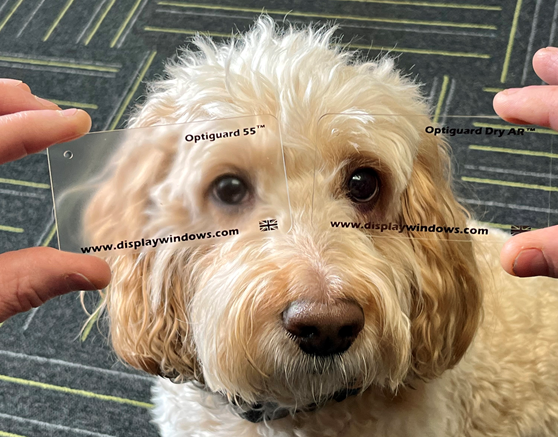
Do I need Anti-glare or Anti-Reflection?
Often when selecting a surface coating for your display, you need to consider a surface treatment to reduce unwanted reflection, this is often where the confusion begins.
What does AR actually mean? Anti Reflective, Anti Reflection, Abrasion Resistant, etc in fact it can mean different things from a Non- Reflective surface treatment to a vacuum deposited coating.
Doug ( the PG office dog ) demonstrates so well the difference. ?
The Optiguard™ 55 coating on the left is a very fine diffused surface coating which is fully abrasion resistant and enables reduction of unwanted surface reflection. However the Optiguard AR coating on the right is a vacuum deposited coating that not only removes the unwanted surface reflection it also improves the optical clarity and colour enhancement as can clearly be seen with Doug’s crystal clear eye.

Why choose Anti-Glare?
Opting for an anti-glare (matt finish) surface coating over anti-reflection (gloss finish) serves various purposes, all aimed at enhancing visibility and user experience in different settings.
The matt finish reduces glare caused by ambient light, like sunlight or artificial lighting, by diffusing reflections across the screen. This minimizes distracting and tiring direct light reflections, crucial in well-lit spaces or outdoors where gloss finishes can produce pronounced reflections, hindering on-screen content clarity.
Matte surfaces also conceal fingerprints and smudges, maintaining a cleaner appearance over time. Moreover, anti-glare coatings contribute to a broader viewing angle, ensuring consistent image quality for users at different screen angles.
While gloss finishes may boost colour vibrancy and contrast indoors, the practicality of anti-glare coatings in reducing glare and maintaining visibility in diverse lighting conditions makes them a preferred choice for practical applications, such as office settings, outdoor use, or bright environments.
Why choose Anti-Reflection?
For applications prioritising visual aesthetics, colour vibrancy, and high contrast, opt for an anti-reflection (gloss finish) surface coating instead of anti-glare (matte finish).
Glossy surfaces excel in producing deep blacks and vibrant colours, making them ideal for multimedia activities like watching movies or playing video games. They reflect light more directly, enhancing graphic richness for an immersive experience. Gloss coatings offer superior optical clarity, avoiding the light scattering typical of matte surfaces.
In controlled indoor settings with low ambient light, anti-reflection coatings deliver a visually striking and crisp display. However, glossy screens are susceptible to glare and reflections, making them less ideal for well-lit or outdoor environments.
Choosing between anti-reflection and anti-glare coatings depends on the specific use case, balancing visual appeal with practical considerations like ambient lighting and potential glare.















